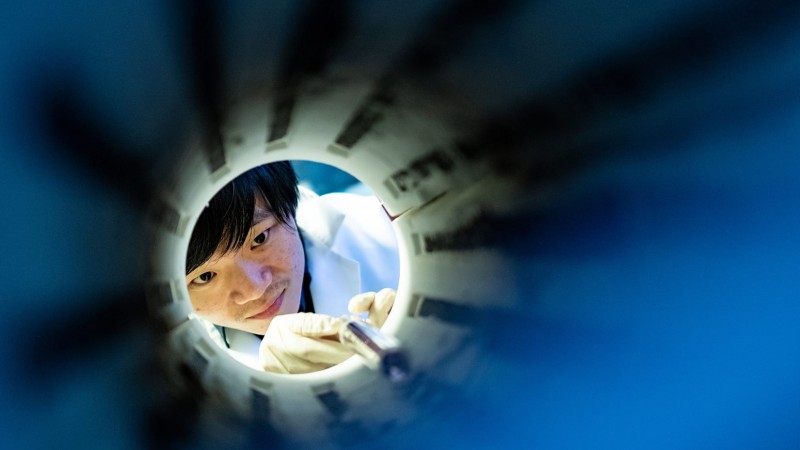A team of U.S. and Korean physicists has found the first evidence of a two-dimensional material that can become a magnetic topological insulator even when it is not placed in a magnetic field.
“Many different quantum and relativistic properties of moving electrons are known in graphene, and people have been interested, ‘Can we see these in magnetic materials that have similar structures?'” said Rice University’s Pengcheng Dai, co-author of a study about the material published in the American Physical Society journal PRX. Dai, whose team included scientists from Rice, Korea University, Oak Ridge National Laboratory (ORNL) and the National Institute of Standards and Technology, said the chromium triiodide (CrI3) used in the new study “is just like the honeycomb of graphene, but it is a magnetic honeycomb.”
In experiments at ORNL’s Spallation Neutron Source, CrI3 samples were bombarded with neutrons. A spectroscopic analysis taken during the tests revealed the presence of collective spin excitations called magnons. Spin, an intrinsic feature of all quantum objects, is a central player in magnetism, and the magnons represent a specific kind of collective behavior by electrons on the chromium atoms.
“The structure of this magnon, how the magnetic wave moves around in this material, is quite similar to how electron waves are moving around in graphene,” said Dai, professor of physics and astronomy and a member of Rice’s Center for Quantum Materials (RCQM).
Both graphene and CrI3 contain Dirac points, which only exist in the electronic band structures of some two-dimensional materials. Named for Paul Dirac, who helped reconcile quantum mechanics with general relativity in the 1920s, Dirac points are features where electrons move at relativistic speeds and behave as if they have zero mass. Dirac’s work played a critical role in physicists’ understanding of both electron spin and electron behavior in 2D topological insulators, bizarre materials that attracted the 2016 Nobel Prize in Physics.
Electrons cannot flow through topological insulators, but can zip around their one-dimensional edges on “edge-mode” superhighways. The materials draw their name from a branch of mathematics known as topology, which 2016 Nobelist Duncan Haldane used to explain edge-mode conduction in a seminal 1988 paper that featured a 2D honeycomb model with a structure remarkably similar to graphene and CrI3.
“The Dirac point is where electrons move just like photons, with zero effective mass, and if they move along the topological edges, there will be no resistance,” said study co-author Jae-Ho Chung, a visiting professor at Rice and professor of physics at Korea University in Seoul, South Korea. “That’s the important point for dissipationless spintronic applications.”
Spintronics is a growing movement within the solid-state electronics community to create spin-based technologies for computation, communicate and information storage and more. Topological insulators with magnon edge states would have an advantage over those with electronic edge states because the magnetic versions would produce no heat, Chung said.
Strictly speaking, magnons aren’t particles but quasiparticles, collective excitations that arise from the behavior of a host of other particles. An analogy would be “the wave” that crowds sometimes perform in sports stadiums. Looking at a single fan, one would simply see a person periodically standing, raising their arms and sitting back down. Only by looking at the entire crowd can one see “the wave.”
“If you look at only one electron spin, it will look like it’s randomly vibrating,” Chung said. “But according to the principals of solid-state physics, this apparently random wobbling is composed of exact waves, well-defined waves. And it doesn’t matter how many waves you have, only a particular wave will behave like a photon. That’s what’s happening around the so-called Dirac point. Everything else is just a simple spin-wave. Only around this Dirac point will the magnon behave like a photon.”
Dai said the evidence for topological spin excitations in the CrI3 is particularly intriguing because it is the first time such evidence has been seen without the application of an external magnetic field.
“There was a paper in the past where something similar was observed by applying a magnetic field, but ours was the first observation in zero field,” he said. “We believe this is because the material has an internal magnetic field that allows this to happen.”
Dai and Chung said the internal magnetic field arises from electrons moving at near relativistic speeds in close proximity to the protons in the nuclei of the chromium and iodine atoms.
“These electrons are moving themselves, but due to relativity, in their frame of reference, they don’t feel like they are moving,” Dai said. “They are just standing there, and their surroundings are moving very fast.”
Chung said, “This motion actually feels the surrounding positive charges as a current moving around it, and that, coupled to the spin of the electron, creates the magnetic field.”
Dai said the tests at ORNL involved cooling the CrI3 samples to below 60 Kelvin and bombarding them with neutrons, which also have magnetic moments. Neutrons that passed close enough to an electron in the sample could then excite spin-wave excitations that could be read with a spectrometer.
“We measured how the spin-wave propagates,” he said. “Essentially, when you twist this one spin, how much do the other spins respond.”
To ensure that neutrons would interact in sufficient numbers with the samples, Rice graduate student and study lead author Lebing Chen spent three months perfecting a recipe for producing flat sheets of CrI3 in a high-temperature furnace. The cooking time for each sample was about 10 days, and controlling temperature variations within the furnace proved critical. After the recipe was perfected, Chen then had to painstakingly stack, align and glue together 40 layers of the material. Because the hexagons in each layer had to be precisely aligned, and the alignment could only be confirmed with Laue X-ray diffraction, each small adjustment could take an hour or more.
“We haven’t proven topological transport is there,” Dai said. “By virtue of having the spectra that we have, we can now say it’s possible to have this edge mode, but we have not shown there is an edge mode.”
The researchers said magnon transport experiments will be needed to prove the edge mode exists, and they hope their findings encourage other groups to attempt those experiments.
Additional co-authors include Bin Gao and Tong Chen, both of Rice, Matthew Stone and Alexander Kolesnikov, both of ORNL, and Qingzhen Huang of the National Institute of Standards and Technology. The research was supported by the National Science Foundation, the Robert A. Welch Foundation, the National Research Foundation of Korea and the Department of Energy.
RCQM leverages global partnerships and the strengths of more than 20 Rice University research groups to address questions related to quantum materials. RCQM is supported by Rice’s offices of the Provost and the Vice Provost for Research, the Wiess School of Natural Sciences, the Brown School of Engineering, the Smalley Institute for Nanoscale Science and Technology and the departments of Physics and Astronomy, Electrical and Computer Engineering, and Materials Science and NanoEngineering.
SNS is a DOE Office of Science User Facility. UT-Battelle manages ORNL for the DOE’s Office of Science. The Office of Science is the single largest supporter of basic research in the physical sciences in the United States and is working to address some of the most pressing challenges of our time. For more information, please visit https://science.energy.gov/.
Original article from Jade Boyd, Rice University.







